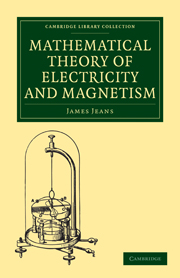CHAP. XII - Induced Magnetism
from MAGNETISM
Published online by Cambridge University Press: 05 August 2011
Summary
PHYSICAL PHENOMENA.
Reference has already been made to the well-known fact that a magnet will attract small pieces of iron or steel which are not themselves magnets. Here we have a phenomenon which at first sight does not seem to be explained by the law of the attractions and repulsions of magnetic poles. It is found, however, that the phenomenon is due to a magnetic “induction” of a kind almost exactly similar to the electrostatic induction already discussed. It can be shewn that a piece of iron or steel, placed in the presence of a magnet, will itself become magnetised. Temporarily, this piece of iron or steel will be possessed of magnetic poles of its own, and the system of attractions and repulsions between these and the poles of the original permanent magnet will account for the forces which are observed to act on the metal.
It has, however, been seen that pairs of corresponding positive and negative poles cannot be separated by more than molecular distances, so that we are led to suppose that each particle of the body in which magnetism is induced must become magnetised, the adjacent poles neutralising one another as in a permanent magnet.
Taking this view, it will be seen that the attraction of a magnet for an unmagnetised body is analogous to the attraction of an electrified body for a piece of dielectric (§ 197), rather than to its attraction for an uncharged conductor.
- Type
- Chapter
- Information
- Mathematical Theory of Electricity and Magnetism , pp. 408 - 424Publisher: Cambridge University PressPrint publication year: 2009First published in: 1908

